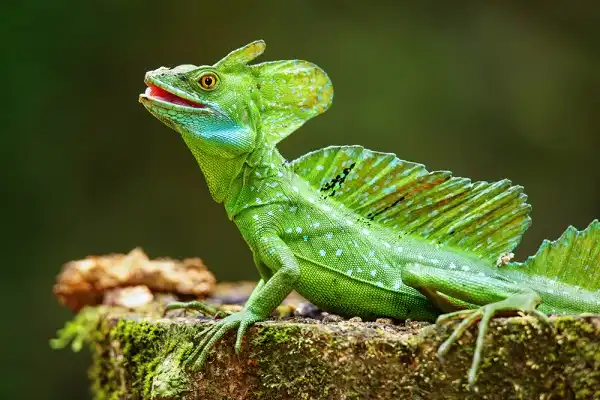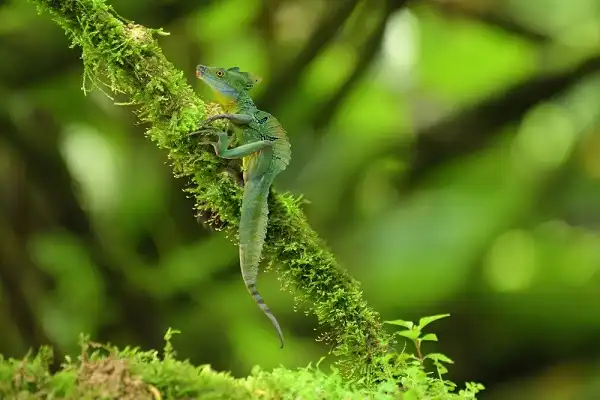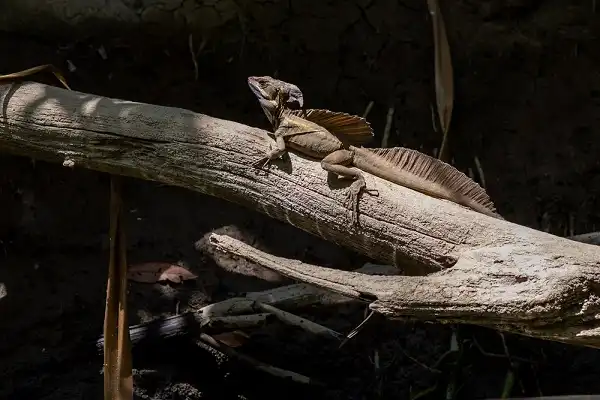Step into the world of fantastic lizards with a closer look at the immensely fascinating Basilisk Lizard. This creature’s remarkable abilities have earned it an array of nicknames, ranging from Jesus Christ Lizard to Jesus Lizard and even The King of Lizards. With its lightning-fast speed, its webs between its toes for swift traversing over water and rock alike, and its unique positions once startled – the Basilisk lizard is truly a sight to behold! From their adaptations that allow them to exist in harsh climates, to Conservation Criteria classes used to measure population size and threats to their survival – get ready to join us on this exploration of every inch of the Basilisk Lizard.

Basilisk Lizard Description
The Basilisk Lizard, an extraordinary reptile native to Central and South America, is renowned for its striking appearance. It possesses a crown-like crest on its head, reminiscent of the ancient Greek legendary creature, the Basilisk, from which it gets its name. Its body color varies, ranging from olive green to brown, providing perfect camouflage amidst the dense vegetation in its natural rainforest habitat. These lizards are medium-sized, with males generally larger than females. This elongated tail not only aids in balance but also serves as a powerful rudder when the lizard skims across water surfaces.
Notably, males are adorned with a large, flap-like crest along their back and tail, significantly adding to their majestic appearance. One of the most striking traits of the Basilisk lizard is its ability to “walk” on water. This unique ability is due to their hind legs, which are equipped with long toes with fringes of skin that unfurl in the water, increasing their surface area. When the lizard runs at a sufficient speed, these “water-walking” adaptations prevent it from sinking, giving the impression that it is miraculously running on the water’s surface, thus earning it the moniker “Jesus Christ Lizard”.
Basilisk Lizard Habitat
Basilisk Lizards are predominantly found in the rainforests of Central and South America, stretching from Southern Mexico to Ecuador. They favor habitats with abundant water bodies, such as rivers and streams, as they provide the lizards with safety from predators, a plentiful food supply, and an easy escape route. These arboreal creatures spend most of their time in trees, descending only to feed, mate, or flee from danger.
The habitat of the Basilisk Lizard is typically characterized by high humidity, dense vegetation, and temperatures ranging from 80 to 90 degrees Fahrenheit. The lush vegetation and the rich biodiversity of the rainforests provide ample food resources for the lizards, including various insects, small mammals, and even birds. The humidity and temperature of their habitat play a significant role in their physiological processes, such as digestion, reproduction, and thermoregulation.
Basilisk Lizard Diet
Basilisk Lizards are omnivorous creatures with a diverse diet, making them excellent survivors in various environments. Their primary food source includes a wide array of insects such as grasshoppers, beetles, and crickets. These agile lizards are proficient hunters, catching their prey with remarkable swiftness and accuracy. Their diet also includes small vertebrates, such as rodents and small birds, particularly chicks snatched from nests.
This extensive range of food sources provides the lizards with a balanced diet rich in proteins and carbohydrates and ensures their survival even in nutrient-poor environments. In addition to insects and small vertebrates, Basilisk Lizards also feed on a variety of plant matter. This includes fruits, leaves, flowers, and stems, particularly in times of food scarcity. Their ability to feed on both animal and plant matter significantly contributes to their adaptability and survival in changing environmental conditions. It’s important to note that the amount and type of plant matter in their diet can vary based on the availability of food and the specific requirements of the lizard.

Basilisk Lizard Size
Basilisk Lizards, also known as “Jesus Christ Lizards,” are medium-sized reptiles with significant size variations observed between males and females. Males are generally larger, measuring up to 2.5 feet (76cm) in length from head to tail. The tail is a notable attribute of their size, contributing to nearly three-quarters of their total length. This elongated tail functions in multiple ways, from aiding balance to serving as a rudder when the lizard skims across water surfaces, and even as a useful tool in predator avoidance.
Females, while smaller than their male counterparts, still pose an impressive size, reaching up to 2 feet (60cm) in length. Their smaller size does not, by any means, diminish their survival capabilities. In fact, the smaller size aids in agility and speed, both of which are vital for evading predators and catching prey. The size difference between the sexes is a common trait seen in several reptile species and is primarily driven by the varied roles males and females fulfill within their ecological niches.
Basilisk Lizard Lifespan
Basilisk Lizards, in their natural habitats, have a lifespan that typically ranges between 5 to 8 years. This lifespan is influenced by a multitude of factors, including the availability of food resources, predator presence, environmental conditions, and disease prevalence. In contrast, those kept in captivity under proper care can live up to 10-12 years, due to the absence of predators and the provision of regular meals, optimal temperatures, and necessary veterinary care.
As with many reptiles, Basilisk Lizards face significant mortality during their early stages of life. Juveniles are particularly vulnerable to predation due to their smaller size and lack of experience. Predators such as birds of prey, snakes, and larger mammals pose a significant threat to their survival. However, as they reach adulthood, their survival rates improve significantly due to their increased size, speed, and better-developed survival instincts.
Basilisk Lizard Behavior
Basilisk Lizards exhibit fascinating behaviors that distinguish them from many other reptile species. One of the most remarkable is their ability to “walk on water,” earning them the nickname “Jesus Christ Lizard.” These lizards achieve this feat by rapidly slapping their hind feet against the water’s surface, creating tiny pockets of air that keep them afloat. In terms of social behavior, Basilisk Lizards are primarily solitary creatures.
Males are territorial, often defending their space against intruding males with aggressive displays that involve head bobbing, body inflation, and mouth gaping. These displays usually deter opponents without necessitating a physical fight. Females, on the other hand, tend to be less territorial. They exhibit less aggressive behavior and are more tolerant of other females within their vicinity, especially when they are not breeding.
Basilisk Lizards are diurnal reptiles, being most active during the day. They spend their time hunting for food, basking in the sun to regulate their body temperature, and watching out for potential predators. While predominantly arboreal, spending considerable time on trees, they are also known to venture onto the ground to forage or escape from danger. Their agile bodies and swift reflexes make them adept climbers and superb swimmers, a testament to their adaptability across diverse environments.

Basilisk Lizard Speed
Basilisk Lizards are renowned for their remarkable speed, both on land and water. This speed is a critical survival adaptation, helping them to escape predators and to hunt efficiently. On land, an adult Basilisk Lizard can sprint at speeds of up to 7 miles per hour. Their lightweight bodies and muscular hind legs enable this swift movement, allowing them to cover ground quickly when under threat or in pursuit of their prey.
In the water, their speed is equally impressive. Using a distinctive method of locomotion, Basilisk Lizards can run across the water’s surface without sinking. This is achieved by rapidly slapping their hind feet against the water, creating a force sufficient for them to stay afloat. They can maintain this “water-walking” at a speed of around 5 miles per hour, although such sprints are typically short-lived due to the energy they require.
Basilisk Lizard Species
There are four recognized species of Basilisk Lizards, each showcasing unique features and adaptations. The Green Basilisk (Basiliscus plumifrons) is the most widely known species, celebrated for its vibrant green scales and large, plume-like crests. Native to the rainforests of Central America, these lizards inhabit areas near water bodies, leveraging their water-walking ability to escape predators. The Brown Basilisk (Basiliscus vittatus), as its name suggests, has brown to olive scales providing effective camouflage in their forest habitats. This species has a broad geographical range, extending from Central America to northern South America.
The Striped Basilisk (Basiliscus galeritus), predominantly found in western Colombia and northwest Ecuador, stands out with its distinctive yellow stripes running along its body. Lastly, the Common Basilisk (Basiliscus basiliscus), also known as the Red-headed Basilisk, sports a bright red or orange head in stark contrast to its predominantly green body. This species inhabits the Pacific coast stretching from Costa Rica to Colombia. Each of these Basilisk Lizard species, with their distinct colors, patterns, and geographical distribution, contributes to the rich biodiversity and ecological balance of their respective habitats.
Basilisk Lizard Reproduction
Basilisk Lizards exhibit a distinct reproductive strategy that contributes to their survival and population growth. The reproductive process begins with courtship, where the male displays to the female through a series of head bobs and pushes-ups. If the female is receptive, she will allow the male to mount and mate. Mating usually takes place during the warmer months, coinciding with the wet season in their natural habitats, providing ample food and optimal conditions for egg development. Females reach sexual maturity at about a year old and can produce multiple clutches of eggs each year.
After mating, the female will lay a clutch of eggs, typically ranging from 10 to 20 eggs, in a carefully dug burrow or nest, which she then covers with soil and leaves. The number of eggs per clutch is impacted by several factors, including the female’s age and health, food availability, and environmental conditions. The eggs are left to incubate in the nest, relying on the heat from the sun and the decay of organic material to provide the necessary warmth. Incubation lasts for about 2-3 months, after which the young lizards, fully independent from birth, emerge. These hatchlings are miniatures of the adults, equipped with the necessary survival instincts, including their signature water-walking ability.

Basilisk Lizard Hunting
Basilisk Lizards are versatile hunters with a diet that encompasses a wide range of prey, displaying the adaptability that characterizes their survival strategy. Their diet includes various insects like beetles, crickets, and grasshoppers, as well as larger invertebrates such as spiders and centipedes. They are also known to consume small vertebrates when the opportunity arises, with their prey list including small rodents, birds, amphibians, and even other smaller reptiles. Their varied diet not only showcases their hunting flexibility but also contributes to the ecological balance of their habitats.
In terms of hunting technique, Basilisk Lizards are primarily ambush predators. They use their excellent camouflage to blend into their surroundings, patiently waiting for prey to stray within striking distance. Once a potential meal ventures too close, the lizard strikes rapidly, using its strong jaws to seize and consume its prey. This ambush strategy, combined with their impressive speed and agility, makes them effective hunters, capable of capturing prey in a variety of terrestrial and arboreal environments. Interestingly, their hunting tactics are not limited to land. Leveraging their unique water-walking ability, Basilisk Lizards can hunt for aquatic prey such as small fish and aquatic invertebrates.
Conclusion
Basilisk Lizards, with their unique physical traits, diverse species, adaptive hunting techniques, and intriguing reproductive strategy, are an exemplary model of survival and adaptability in the animal kingdom. Their ability to thrive in a variety of habitats, and their role in maintaining the ecological balance, make them a critical part of the rich biodiversity of Central and South America. Conservation efforts are essential to ensure the survival and growth of these intriguing creatures. Their study not only enriches our understanding of reptilian biology but also provides insights into the intricate designs of nature. Indeed, the Basilisk Lizard is a fascinating subject in the realm of herpetology, evoking wonder and curiosity about the marvels of animal adaptation and survival.
Frequently Asked Question
Are Basilisk Lizards poisonous?
No, Basilisk Lizards are not poisonous. They do not produce or inject venom. However, they are remarkable for their ability to run on water using their specialized feet.
What is the diet of the Basilisk Lizard?
The diet of the Basilisk Lizard primarily consists of insects, small invertebrates, and sometimes small vertebrates like fish or amphibians. They are opportunistic feeders and are known to be insectivorous.
What are the predators of the Basilisk Lizard?
The main predators of the Basilisk Lizard include birds of prey such as hawks and eagles, as well as larger snakes and carnivorous mammals. They rely on their agility and speed to escape from these predators.
What are the different species of Basilisk Lizards?
There are several species of Basilisk Lizards, including the Green Basilisk (Basiliscus plumifrons), Brown Basilisk (Basiliscus vittatus), and Western Basilisk (Basiliscus galeritus), among others. Each species has unique characteristics and habitats.


